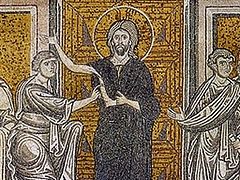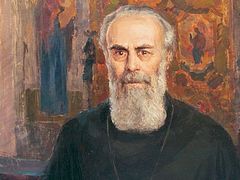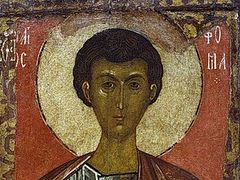
When Mary Magdalene brought her news to the disciples, it is likely that they reacted in one of two ways: either they did not believe her, or, if they did, they were crestfallen because they were not deemed worthy to see Christ. Meanwhile, fear of the Jews was increasing the disciples’ longing to see the only One Who could relieve their anxiety. And so the Lord appeared to them that very evening, when all of them were gathered together. It is written that He appeared when the doors were shut, meaning, He entered through locked doors. This was to show that He had risen in the very same manner, while the entrance to the tomb was shut with a stone. One would think they might have taken Him for a ghost, but Mary Magdalene’s testimony had greatly strengthened their faith. Also, He manifested Himself in such a way as to calm their tumultuous thoughts: Peace be unto you, He said gently, meaning, “Be not afraid.” This was to remind them of what He had told them before the crucifixion: My peace I give unto you (Jn. 14:27). Then were the disciples glad, when they saw the Lord. This, too, He had foretold before His death: I will see you again, and your heart shall rejoice (Jn. 16:22). It was well that He should say to them again, Peace, for the disciples were now engaged in desperate struggle with the Jews. As He had said, Rejoice! to the women (Mt. 28:9), because sorrows were their lot, so He grants peace to the disciples, who were now, and would always be, at war with the Jews.
It is fitting that He grants joy to the women, condemned to bear children in pain and suffering; and peace to the men, on account of the warfare that would engulf them for preaching the Gospel. At the same time He reveals that the cross has ushered in peace: “The cross has brought peace: now I send you forth to proclaim it.” To strengthen and embolden the disciples, He declares, “As My Father hath sent Me, even so send I you. It is My work you have undertaken, so do it boldly: I will be with you.” Behold the authority of his command: “It is I Who sends you (̓Εγὼ πέμπω ὑμᾶς).” No longer does He condescend to the limitations of their understanding, saying as He often did before the resurrection, “I will ask My Father and He will send you.” Now He breathes on them and gives them the Holy Spirit—but not the entirety of the gift He would bestow at Pentecost. Receive ye the Holy Spirit, means, “Let this partial bestowal of grace make you ready to receive later the fullness of the Holy Spirit.” The words, Whose soever sins ye remit, they are remitted unto them, indicate the particular gift He gives the disciples now: power to forgive sins. Later, on Pentecost, the Holy Spirit Himself would descend in all His might, lavishing upon the apostles every spiritual gift and power to work wondrous deeds, such as raising the dead.
It is worth considering why John records only that Christ appeared to His disciples in Jerusalem, while Matthew and Mark say that He promised to appear to them in Galilee (see Mt. 26:32; Mk. 14:28). Some have explained it this way: “Christ never said He would appear to the disciples only in Galilee, and not in Jerusalem. In Jerusalem, He appeared to the twelve, whereas in Galilee, He appeared to all His disciples, in accordance with His promise. The fact that He showed Himself many times to the twelve indicates that He honored them more highly than the others.” From this we again see that there are no irreconcilable disagreements between the accounts of the Evangelists. There were many appearances of the Lord after His resurrection, and each Evangelist selected certain ones to record. When two Evangelists describe the same event, the second usually tells what the first has omitted. And now, O reader, reflect upon the divine rank of the priesthood. The power to forgive sins is a divine power; hence, we must show honor to the priests as to God. Even if they are unworthy, they are still ministers of divine gifts, and grace empowers them (ἐνεργεῖ διʹαὐτῶν) just as it empowered Balaam’s ass, enabling it to speak (see Num. 22:28-30). Human frailty does not hinder the working of grace. Therefore, since grace is bestowed through the priests, let us honor them.
24–29. But Thomas, one of the twelve, called Didymus, was not with them when Jesus came. The other disciples therefore said unto him, We have seen the Lord. But he said unto them, Except I shall see in His hands the print of the nails, and put my finger into the print of the nails, and thrust my hand into His side, I will not believe. And after eight days again his disciples were within, and Thomas with them: then came Jesus, the doors being shut, and stood in the midst, and said, Peace be unto you. Then saith He to Thomas, Reach hither thy finger, and behold My hands; and reach hither thy hand and thrust it into My side: and be not faithless, but believing. And Thomas answered and said unto Him, My Lord and My God. Jesus saith unto him, Thomas, because thou hast seen Me, thou hast believed: blessed are they that have not seen, and yet have believed.
Thomas … was not with the disciples, perhaps because he had not yet returned from where he was hiding after the disciples had scattered. Elsewhere, we learned that the Hebrew name “Cephas” means “Rock” (Πέτρος, see Jn. 1:42); here we are told that “Thomas” means “Twin” (Δίδυμος). The Evangelist provides the meaning of the name here to indicate that Thomas was prone to be of two minds—a doubter by nature. He doubted the news brought to him by the others, not because he thought they were liars, but because he considered it impossible for a man to rise from the dead. And his doubt made him excessively inquisitive. Gullibility is a sign of light-mindedness; but stubborn resistance to truth is a sure indication of thick-headedness. Thomas would not even trust his eyes, but demanded proof by touch, the least discriminating of the senses: except I shall … thrust my hand into His side. How did Thomas know there were wounds in Christ’s hands and side? Because the other disciples had told him. And why does the Lord wait eight days before appearing to him? To allow time for each of Thomas’ fellow disciples to tell him what they had witnessed. Hearing the same story from each one individually made him more willing to believe, and increased his desire to see the Lord. In order to show that He was invisibly present eight days earlier, when Thomas had expressed disbelief, the Lord does not wait for Thomas to speak. Instead, He straightway proposes exactly what Thomas desired, quoting his very words.
First He rebukes Thomas, saying, Reach hither thy hand; then He admonishes him: and be not faithless, but believing. From this it is clear that Thomas’ doubt was caused by lack of faith, and not because he was careful to verify the facts (as some say, wishing to put him in better light). But as soon as Thomas touched the Lord’s side, he was revealed as a superb theologian, proclaiming the two natures and single hypostasis of the one Christ. Thomas refers to the human nature of Christ, calling Him Lord; for the term “Lord” (Κύριος) is applied not just to God, but to men as well. (Thinking that Jesus was the gardener, Mary Magdalene had said to Him, Sir (Κύριε), if thou have borne Him hence… (v. 15). But when Thomas cries out, …and My God, he confesses Christ’s divine essence, and affirms that the names Lord and Godrefer to one and the same Person. By declaring blessed those who have not seen, and yet have believed, the Lord teaches us that faith means the acceptance of things not seen. He is referring, first to the disciples who believed without touching His side or the print of the nails, and second to those who would later believe (without any physical confirmation). He is not depriving Thomas of his share of blessedness, but encouraging all who have not seen. There was a common saying, “Blessed are the eyes that have seen the Lord.” Christ, however, praises those who will believe without seeing, declaring them to be truly blessed.
A question arises: how can an incorruptible body display the mark of nails and be touched by human hands? The answer is that such things are possible as part of the divine economia: they are manifestations of God’s condescension and love for man. By entering the room when the doors were shut, Christ makes it absolutely clear that after the resurrection His body is altered: it is now light and subtle, free of all material coarseness. But to confirm that it is indeed their Lord and Master Who has appeared to them, He permits His resurrected body, bearing the wounds of the crucifixion, to be touched. For the same reason, when He walked on the water before the Passion (see Mk. 6:48]), His body was unchanged from when He was walking about on land, and this reassured the disciples. But though He allows His resurrected body to be touched, it is now impassible and incorruptible. When Christ eats now with the disciples, it is no longer to satisfy any physical demands of His body (for there were none). Food once eaten is altered in the stomach and passes out into the drain (see Mt. 15:17). But it was not so with Christ after the resurrection. The food He ate during that time was consumed by an invisible, divine power. His only purpose in eating was to confirm the reality of His resurrection, and He permitted His incorruptible body to bear the mark of nails, and to be handled, for the same reason. Do you see, O reader, how, in order to save one doubting soul, the Lord did not spare His own dignity, but condescended to bare His side? Neither should we despise even the least of our brethren.
30–31. And many other signs truly did Jesus in the presence of His disciples, which are not written in this book. But these are written, that ye might believe that Jesus is the Christ, the Son of God; and that believing ye might have life through His name.
To what other signs is the Evangelist referring? To those that Jesus did after the resurrection, and not those before His crucifixion, as one might suppose. The Evangelist is speaking about the signs which Jesus did in the presence of His disciples only. The miracles before the Passion were performed in the presence of the multitude and revealed Jesus to all as the Son of God. The miracles after the resurrection were performed while He was alone with the disciples during the forty days: their purpose was to convince them that He was still the Son of man, with a human body, albeit one now incorruptible, more Godlike, and no longer subject to the laws of the flesh. Of the many miracles after the resurrection, only these are written. They are not described ostentatiously, to vaunt the glory of the Only-begotten, but simply, as the Evangelist says—that ye might believe. So what is the profit here, and to whom does it accrue? Certainly not to Christ, for what does He gain by our belief? It is we who gain. The Evangelist himself tells us that he wrote so that believing ye might have life through Jesus’ name. When we believe that Jesus rose from dead and lives, we win for ourselves eternal life. He arose, and is alive, for our sake. But whoever imagines that Christ is dead and did not rise from the grave has no life in him. Indeed, by thinking this he confirms and ensures his own eternal death and corruption.



